HTPC - TV Tuner Reviews
by Jarred Walton on December 7, 2005 12:05 AM EST- Posted in
- Smartphones
- Mobile
Performance Considerations
We've talked a lot about the cards, but we haven't said much about the actual performance or CPU usage. It varies by card, as well as what content you're watching, so we captured some graphs showing CPU usage in a variety of situations. For the most part, anything faster than around 1.6 GHz P4 or 1600+ Athlon should suffice, though just to be safe, you might want closer to 2.4 GHz/2400+. Using the Sempron 64 running at 2.50 GHz was more than sufficient for everything but the MyHD analog recording. Let's start first by looking at how each card performs in analog mode. The MyHD and Theater 550 are running on the Athlon 64 4000+ HP system, while the Fusion5 is in the Sempron system. Don't worry - we're only looking for a rough estimate of CPU power requirements, and the Fusion5 worked fine with the Sempron as well as the slightly faster HP.
For watching analog content, not only is the Theater 550 a better image, but it also uses far less CPU power. In fact, the image for watching and recording with the Theater 550 is the same. Can you spot the point where we enabled recording in the graph? (The higher CPU usage at the start is actually PowerCinema loading, so don't confuse that with the latter portion of the chart.) We began recording the station on the 550 around the spot marked by the two "peaks" where CPU use spiked to 40% or so. Otherwise, CPU use remains around 10%.
The Fusion does quite well when only viewing analog channels, averaging around 20% CPU use on the Sempron system and slightly less (15%) on the 4000+ (which we didn't capture). Recording with the Fusion5 kicks CPU usage up to about 60%. That's a pretty big jump, but we were running with a maximized viewport (720p content), and we didn't experience any stalls or other problems. For watching an analog channel, the Fusion5 is a close second to the Theater 550, though it's a distant second for recording the content.
Finally, we have the MyHD card. Similar to the Fusion, watching an analog channel uses less CPU time than recording the channel. However, less in this case means about 40% CPU usage. Enabling even the fastest DivX encoding (with MP3 audio) kicks the CPU up to almost 80% usage. The video capture doesn't cut out, but there does seem to be a slight delay every second or so. Even though there is supposedly 20% idle CPU time, the capture isn't really clean, and it's about equal to watching TV with only mediocre reception. We don't have a graph, but moving to the 2.6 GHz X2 chip with Normal quality DivX encoding still used a whopping 65% of the CPU time - remember that there are two cores, so that would be over 130% CPU time for the 4000+. The faster X2 also removed the slight lag in the video, all while producing a much better encode.
Here's another version of the data, with a few additional reference points. The graphs are colored according to performance: green indicates that there were no difficulties, yellow means that there may be periodic issues, and red means that the result was unacceptable.
Moving to digital channels removes the Theater 550 from the list, but we have both the DxVA accelerated and non-DxVA modes in FusionHDTV. Most modern GPUs can use the DxVA acceleration, so consider the non-DxVA charts to be a worst case scenario. All of the results were taken while viewing a 1080i football game broadcast.
With DxVA enabled, watching 1080i with the Fusion5 requires about 20% of your CPU time. Recoding the same content appears to add about 10% more CPU use, and we get close to 30%. The non-DxVA mode requires quite a bit more power to handle the decoding of the digital signal, using 45% of the CPU power. As before, recording the same content appears to add another 10%. Remember that unlike analog signals, digital TV is already compressed. Decompressing is quite a bit easier than compressing a signal, which is why a Sempron can handle 1920x1080 video at 30 FPS without trouble, whereas the same CPU chokes when attempting to encode even 640x480 video at 30 FPS.
Viewing digital content with the MyHD is completely different from using the card in analog mode. CPU usage on the 4000+ was around 25% when viewing a 1080i signal, though disabling the overlay screen knocks that down around 15%. The record mode oddly enough has consistently lower CPU usage, at around 12 or 13%. The hardware acceleration of DTV decoding that the MyHD card provides is clearly put to good use.
Again, here's the simplified graph. All of the results are green, as there were no difficulties. Judging by the CPU usage on the Sempron for the MyHD, most of the CPU usage is used by the overlay window.
We've talked a lot about the cards, but we haven't said much about the actual performance or CPU usage. It varies by card, as well as what content you're watching, so we captured some graphs showing CPU usage in a variety of situations. For the most part, anything faster than around 1.6 GHz P4 or 1600+ Athlon should suffice, though just to be safe, you might want closer to 2.4 GHz/2400+. Using the Sempron 64 running at 2.50 GHz was more than sufficient for everything but the MyHD analog recording. Let's start first by looking at how each card performs in analog mode. The MyHD and Theater 550 are running on the Athlon 64 4000+ HP system, while the Fusion5 is in the Sempron system. Don't worry - we're only looking for a rough estimate of CPU power requirements, and the Fusion5 worked fine with the Sempron as well as the slightly faster HP.
Analog Channels (watching on left, recording on right)
| FusionHDTV | |
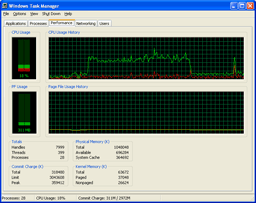 |
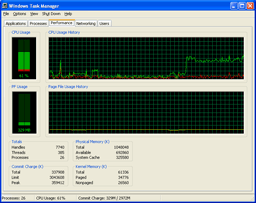 |
| Click to enlarge. | |
| MyHD | |
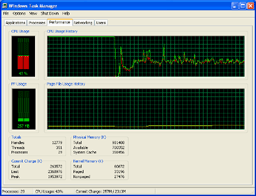
| 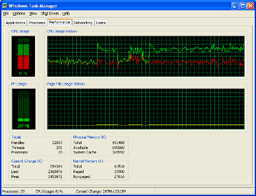 |
| Click to enlarge. | |
| Theater 550 | |
 |
 |
| Click to enlarge. | |
For watching analog content, not only is the Theater 550 a better image, but it also uses far less CPU power. In fact, the image for watching and recording with the Theater 550 is the same. Can you spot the point where we enabled recording in the graph? (The higher CPU usage at the start is actually PowerCinema loading, so don't confuse that with the latter portion of the chart.) We began recording the station on the 550 around the spot marked by the two "peaks" where CPU use spiked to 40% or so. Otherwise, CPU use remains around 10%.
The Fusion does quite well when only viewing analog channels, averaging around 20% CPU use on the Sempron system and slightly less (15%) on the 4000+ (which we didn't capture). Recording with the Fusion5 kicks CPU usage up to about 60%. That's a pretty big jump, but we were running with a maximized viewport (720p content), and we didn't experience any stalls or other problems. For watching an analog channel, the Fusion5 is a close second to the Theater 550, though it's a distant second for recording the content.
Finally, we have the MyHD card. Similar to the Fusion, watching an analog channel uses less CPU time than recording the channel. However, less in this case means about 40% CPU usage. Enabling even the fastest DivX encoding (with MP3 audio) kicks the CPU up to almost 80% usage. The video capture doesn't cut out, but there does seem to be a slight delay every second or so. Even though there is supposedly 20% idle CPU time, the capture isn't really clean, and it's about equal to watching TV with only mediocre reception. We don't have a graph, but moving to the 2.6 GHz X2 chip with Normal quality DivX encoding still used a whopping 65% of the CPU time - remember that there are two cores, so that would be over 130% CPU time for the 4000+. The faster X2 also removed the slight lag in the video, all while producing a much better encode.
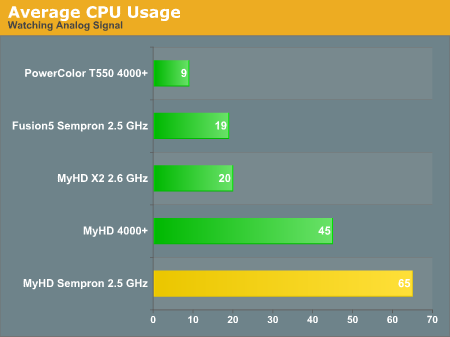
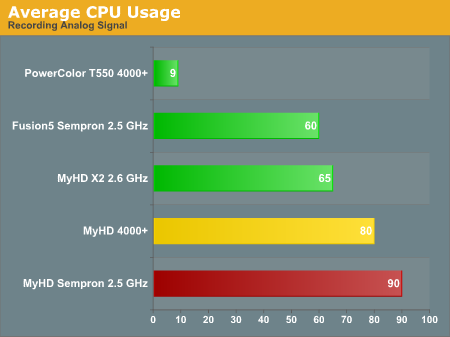
Here's another version of the data, with a few additional reference points. The graphs are colored according to performance: green indicates that there were no difficulties, yellow means that there may be periodic issues, and red means that the result was unacceptable.
Digital Channels (watching on left, recording on right)
| FusionHDTV DxVA | |
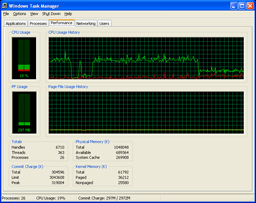 |
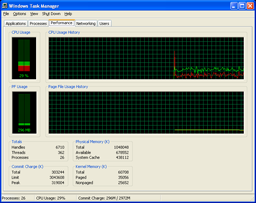 |
| Click to enlarge. | |
| FusionHDTV non-DxVA | |
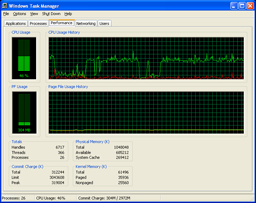 |
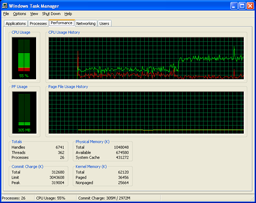 |
| Click to enlarge. | |
| MyHD | |
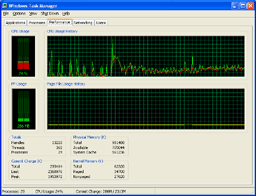 |
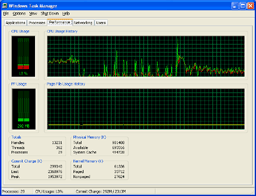 |
| Click to enlarge. | |
Moving to digital channels removes the Theater 550 from the list, but we have both the DxVA accelerated and non-DxVA modes in FusionHDTV. Most modern GPUs can use the DxVA acceleration, so consider the non-DxVA charts to be a worst case scenario. All of the results were taken while viewing a 1080i football game broadcast.
With DxVA enabled, watching 1080i with the Fusion5 requires about 20% of your CPU time. Recoding the same content appears to add about 10% more CPU use, and we get close to 30%. The non-DxVA mode requires quite a bit more power to handle the decoding of the digital signal, using 45% of the CPU power. As before, recording the same content appears to add another 10%. Remember that unlike analog signals, digital TV is already compressed. Decompressing is quite a bit easier than compressing a signal, which is why a Sempron can handle 1920x1080 video at 30 FPS without trouble, whereas the same CPU chokes when attempting to encode even 640x480 video at 30 FPS.
Viewing digital content with the MyHD is completely different from using the card in analog mode. CPU usage on the 4000+ was around 25% when viewing a 1080i signal, though disabling the overlay screen knocks that down around 15%. The record mode oddly enough has consistently lower CPU usage, at around 12 or 13%. The hardware acceleration of DTV decoding that the MyHD card provides is clearly put to good use.
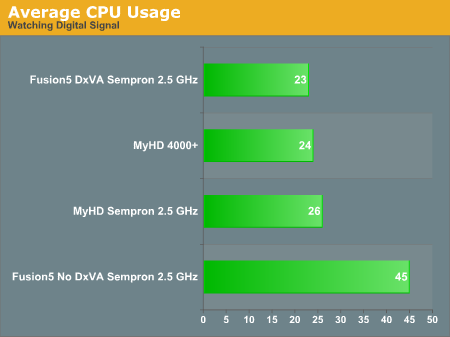
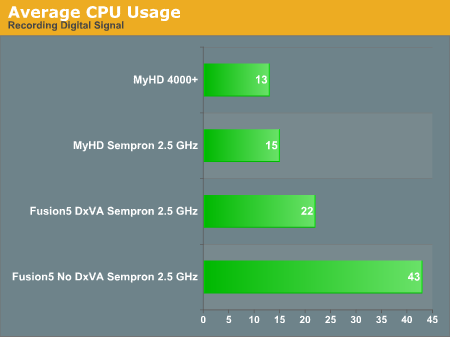
Again, here's the simplified graph. All of the results are green, as there were no difficulties. Judging by the CPU usage on the Sempron for the MyHD, most of the CPU usage is used by the overlay window.










77 Comments
View All Comments
8steve8 - Wednesday, December 7, 2005 - link
bottom line:if i want to watch/record hdtv channels like HBO and/or discover via a PC...
im out of luck?
those channels are not ota... are provided through a cable provider....
i can do this once cable card finally comes around?
JarredWalton - Wednesday, December 7, 2005 - link
HBO and most other movie channels are encrypted. Funny enough, some of the on demand channels seem to be picked up. For instance channels 101-1, 101-2, 102-1, 102-2, and several subchannels on the physical channels 93 and 94 all showed what amounts to random content. Movies, cartoons, and yes, even porn. If you tuned in to one of the channels, sometimes you would see it going to fast-forward mode, like the person watching the content was skipping ahead.Cable card is supposed to allow you to view encrypted content on TVs as well as computers without a set-top box. Until I see it in actual use, though, I'm not exactly sure how it's going to work. I would assume it will just store an encrypted TP file, and the cable card will contain the decryption logic.
nullpointerus - Wednesday, December 7, 2005 - link
http://en.wikipedia.org/wiki/Cablecard">http://en.wikipedia.org/wiki/CablecardI've been waiting for decent HTPC CableCard products for ~2 years now. They'll probably come out very late in 2006, achieve their intended interoperability sometime between the second and third generation of products, and become practically flawless around the same time that they become obsolete. That's just a guess, mind you...
Tujan - Wednesday, December 7, 2005 - link
It was intriging because nobody has really compared the use of DIY HTPCs. With what limited parts are available.I wouldn't use a non-multicore processor for something dealing with HDPCs. Just the shear amount of graphics and screen space,the relative newcomer to its display of screen space,. The notorious 'switching between apps,and those running in the background,- much less using the PCI bus to do so.
What I did miss out of this story,was a shot of a connected MYHD130 to its screen display. Kind of lost me there. With the connect ups to utilizing a screen,and the computers video card. See Im reading imagining toggling between user interface,remote,and what this means to the rigging of separate devices outside the computer itself.Caveat Emptor for/from them along side. And you mentioned that ATI was 'out-of-the-picture , for HDTV unless the components where hooked up. So to share that ATI graphics cards are not useful for the MYHD130.
Would certainly make a wish list to the MYHD130 to put it onto the PCI-e lane.Get it off the PCI bus.
As for those encrypted channels.Are you sure they would stay that way ? Think you could pick out your PPV (Pay-Per-view) channel from that list ? [ ]
You mentioned your Monitor,that they have in common Overscan.I simply have the question included to involve just how a HTPC will correctly recognize a monitor (consider a 32 to 40" LCD TV) ,when most this involves the PNP feature Ive known for doing so.? [ ]
ATI cards aren't any good with the DTV if using the DVI for/from them for the HD screens ? Think 32" to 42" LCD TVs here.[ ]
- glad your doing the experimenting here.Good article.
JarredWalton - Wednesday, December 7, 2005 - link
LCD TVs shouldn't have a problem with overscan. Any rear projection displays will have overscan, and I believe all DLP have overscan as well. There are some good DLP displays that only have 1% overscan, though -- too bad they're really expensive.If you want a picture of what the MyHD looks like when connected, let me see about uploading one and I'll provide a link. This is with the DVI daughter card:
http://images.anandtech.com/reviews/multimedia/tvt...">DVI Passthru Image
http://images.anandtech.com/reviews/multimedia/tvt...">VGA Passthru Image
Hopefully that's clear - there's a lot of cable clutter, so I labeled the pertinent connections.
Tujan - Wednesday, December 7, 2005 - link
Thanks for reply. Even though I know a lot,Im still a novice. Know a lot of the acronymns,but dealing with things marketed off the top just keeps me on to them for a limited span.The picture there,the top card is the video card,with the lower cards being the TV tuners then.Im thinkin that somehow your giving up a controlled connection to your display from the computer by using the MyHD130 ? Or it limits the 'out of your video card when you only would have a single hook up on the Display.[ ]
- I will go to there site to look for more.
Encryption ? [ ] Mean if you subscribe to HBO via your home cable line,HBO will not be able to be seen if utilizing the HTPC with the QAM/HD TV cards ?
Certainly the situation would be averted for the configuration of the cable to Display(cable box to default display) - since (T,F) the Display has an encryption chip within it to do so,(1),or (2) Encryption is handled via the cable box. With everything else dealing with something of the HDCP,HDMI type scenarios.... The encryption mechanism has got to work somewhere in the final render at the Display. Certainly the Cable Company isn't selling me the Display.....
Of course this is a whole nother anchalotta.
I pretty much just look for the configuration compatibility in the input,output for the hookups.And if the software will work/..how difficult to navigate them.
Thinking everythings hunky dory after a large investment ...Again thanks for reply.
JarredWalton - Wednesday, December 7, 2005 - link
Decryption of the encrypted channels is handled by the cable box. The cable card standard will allow other devices to do that decryption -- basically, the key/algorithm will be stored on the cable card. Of course, that means you need to have a TV and or computer that has a cable card slot. Hopefully they'll make a USB adapter.mariush - Wednesday, December 7, 2005 - link
I'm a bit dissapointed that you have used Divx to test the analog recording. XViD would have probably been much faster, at least that's how it is on my computer.Also, I would probably either use XViD set to record with quantizer 1 (max quality) which takes about 6-10 MB/s at 768x576 25fps or I would use a lossless encoder such as HuffYUV (~12 MB/s at 768x576 25fps)
JarredWalton - Wednesday, December 7, 2005 - link
The DivX codec is officially supported by the MyHD software. Xvid was far slower, and that holds in general, unless there is a special setting to get it to encode faster. All the real-time encoding has to be done through a VFW codec, and I couldn't find a fast codec to handle that. The DivX codec is also the only codec that allows you to resize the video content, at least as far as I could tell. Otherwise you end up with an incorrect aspect ratio, as seen on the top left picture on page 15.If you download the videos, you might feel that the DivX codec results in a loss of quality, even on the X2 system. That video sample is actually very close to what you see when watching live analog content with the MyHD card. At best, it's decent analog video. Just about any analog-only TV tuner will produce equal or better output.
Back to the codecs, if you really want to get a decent compression, while not losing a lot of quality, I would recommend using a second PC or re-encoding the videos while your computer is sitting idle. You could do the same thing with the TP files, re-encoding them using the Xvid codec with a data rate of around 1 GB per hour and the target, resolution of 720 x 480 -- or perhaps go for 2/3 GB per hour and target a 1280x1024 resolution.
One of the benefits of the DivX codec is that quite a few consumer-electronics devices now support it as well. I'm not aware of any DVD players that can handle Xvid.
xtknight - Wednesday, December 7, 2005 - link
Sorry for the double post, but by the way, the program AVI.NET can encode xvid and divx for standalone players. That's the whole purpose of it: to use only the features standalone players support. I recommend you try it out.